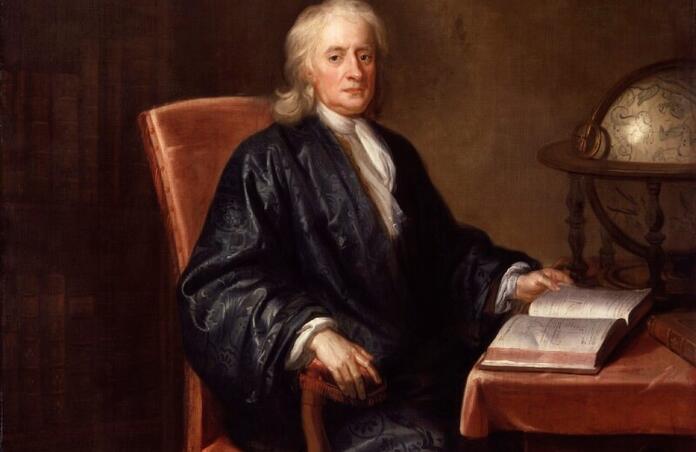Sir Isaac Newton

January 4th is the Gregorian Calendar 381st birthday for mathematician, philosopher & scientist Sir Isaac Newton [1643-1726]. Throughout his lifetime, the British used the old Julian calendar, in which the first day of the year was March 1st. They did not switch to the Gregorian calendar that we use today, until 1752. So Newton would have celebrated his birthday as Christmas Day, 1642, which translates into today, in the proleptic Gregorian calendar, where the word proleptic means that the calendar is being extended back in time, to a date before it was used.
Newton is likely the most famous of all the people we vaguely call scientists today, although that word was not used back then (the word "scientist" was invented in 1834 by English philosopher William Whewell [1794-1866]). Newton was a natural philosopher, in the language of his time. And we must remember too, that in the 1600s & 1700s, religion, philosophy, and science, were strongly intertwined with each other, in a manner that would be very abnormal by today’s standards.
Newton is best known today as the inventor of calculus. But in fact, Newton, and German mathematician Gottfried Wilhelm Leibniz [1646-1716] invented calculus at about the same time, and likely independent of each other (roughly 1665-1675). But a bitter dispute broke out between Newton (and the British Empire) and Leibniz (and the European continent), over who deserved priority for discovering calculus first. There were strong national rivalries at work in those days. Newton’s method of symbolic manipulation was easy for his own facile mind to follow, but just about everyone else found it opaque & difficult. On the other hand, the Leibniz method was easier for non-Leibniz people to follow the logic. As a result, for about a century after Newton, nearly all of the big advances in mathematics were made on the continent, while stubborn British mathematicians refused to adopt continental methods, and stuck with the Newtonian ways. It took one of the most overlooked geniuses of all time, Sir John Frederick William Herschel [1792-1871], beginning in 1812, to push British mathematics to adopt the superior continental methods (along with George Peacock [1791-1858] and Charles Babbage [1791-1871]).
Aside from his fame in the mathematics of calculus, Newton was also a pioneer in the science we now call physics. He essentially invented classical mechanics ("Principia", 1687), wherein he created a unified physical & mathematical context, for what appeared to be a scattering of unconnected problems & phenomena. It was the first work of “unification” in physics, an idea that persists today, in the search for a unified theory of everything. In this case the national rivalries worked the other way. In particular, the French considered it insulting to adopt the science of an Englishman. The bitter rivalry centered on the shape of the Earth, and the French were thoroughly annoyed when detailed surveys proved that Earth had an English shape (larger equatorial than polar radius), rather then a French shape (larger polar than equatorial radius). Newton also wrote the first seriously physical treatise on optics ("Opticks", 1704-1706). But note that the earlier works of Johannes Kepler (Astronomiae Pars Optica, 1604; Dioptrice, 1611) dealt with the practical applications of image manipulation with lenses (including the physiology of the human eye), whereas Newton explored the nature of light itself. Newton was the first to prove that the colors of the rainbow were a property of the light itself, and not the material it was passing through. But all of Newton’s famous advances in science only represent about a quarter of his total intellectual output. He spent a great deal of effort studying the astrological alignments of religious temples. And he wrote several tracts, in search of hidden messages in the Bible, including literary & symbolic manipulations of biblical texts. He was also an alchemist, and spent considerable effort trying to chemically change one element into another. While we recognize this as hopeless today, how was anyone in the 1600s supposed to know it’s impossible?
Newton became Master of the Royal Mint in 1699, and held that post for the rest of his life. His diaries show that he was meticulous & tenacious in tracking down counterfeiters, and making certain of their final demise.
And finally, amongst his numerous scientific achievements, it should be noted that Newton was well aware of the problem of the general relativity of motion, and tried to solve it himself, with his spinning bucket problem (see link below). But the general relativity of motion was a nut too tough even for Newton to crack. It took centuries, before Albert Einstein [1879-1955] finally solved the problem, by the surprising approach of including the law of gravity, which surely never occurred to Newton, who had himself only just devised the very first law of gravity.
See the book “Never At Rest: A Biography of Isaac Newton” by Richard Westfall (1983), for the definitive biography of Newton. His life includes far more than I can squeeze into a thumbnail sketch like this. The portrait here comes from the National Portrait Gallery in London, and is probably posthumous (dated circa 1726-1730). The portrait is attributed to Enoch Seeman [1689-1744], or his studio, and likely commissioned by Newton’s family. The book he is holding is identifiable by the diagrams as the 3rd edition (1726) of the Principia (pages 204-205). Quoting the NPG description: “A portrait of Newton at the very end of his life. The head derives from a bust-length portrait in Trinity College, Cambridge, inscribed Isaac Newton 1726, presented in 1761 by Thomas Hollis, and engraved in 1760 by Macardell as after Seeman.”
Originally written by Tim Thompson, retired Senior Astronomer, NASA JPL
References
https://en.wikipedia.org/wiki/Isaac_Newton (Wikipedia) https://en.wikiquote.org/wiki/Isaac_Newton (Wikiquote) https://www.newtonproject.ox.ac.uk/ (The Newton Project - University of Oxford) https://plato.stanford.edu/entries/newton/ (Stanford Encyclopedia of Philosophy - Stanford University) https://cudl.lib.cam.ac.uk/collections/newton/1 (Isaac Newton Papers - Trinity College, University of Cambridge) https://www.newworldencyclopedia.org/entry/Isaac_Newton (New World Encyclopedia) https://mathshistory.st-andrews.ac.uk/Biographies/Newton/ (Mathematical biography - University of St. Andrews, Scotland) https://www.genealogy.math.ndsu.nodak.edu/id.php?id=74313 (Mathematics Genealogy Project) https://makingscience.royalsociety.org/.../fst01801333 (Science in the Making - Royal Society) https://www.thoughtco.com/biography-sir-isaac-newton-4072880 (ThoughtCo) https://www.maths.tcd.ie/.../Newton/RouseBall/RB_Newton.html (Trinity College, Dublin) https://www.westminster-abbey.org/.../sir-isaac-newton (Westminster Abbey) https://www.bbc.co.uk/.../isaac-newton-the-man.../zh8792p (“Isaac Newton: The man who discovered gravity” - BBC) https://en.wikipedia.org/.../Religious_views_of_Isaac_Newton (Religious views of Isaac Newton - Wikipedia) https://en.wikipedia.org/wiki/Philosophiæ_Naturalis_Principia_Mathematica (Principia, 1687)https://en.wikipedia.org/wiki/Opticks (Optics, 1704-1706)https://en.wikipedia.org/wiki/Calculus (Calculus - Wikipedia) https://en.wikipedia.org/wiki/Leibniz–Newton_calculus_controversy (Leibniz-Newton calculus controversy - Wikipedia) https://en.wikipedia.org/wiki/Bucket_argument (Newton’s spinning bucket - Wikipedia)https://books.google.com/books/about/Never_at_Rest.html... (Never At Rest - Google Books)https://www.npg.org.uk/.../portr.../mw04661/Sir-Isaac-Newton (Portrait source - National Portrait Gallery, London)
